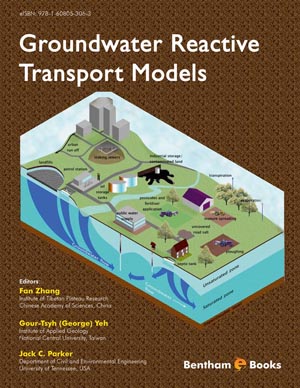Introduction and Overview
Page: 3-10 (8)
Author: Richard B. Philp
DOI: 10.2174/978160805102111201010003
PDF Price: $15
Abstract
The distribution of pollutants amongst air, soil and water is a complex process affected by winds, tides, precipitation (especially floods) and, most recently, by climate change. This chapter reviews the essential components of this process and sets the stage for subsequent chapters with regard to specific pollutants and their sources. Pollutants can be exchanged amongst soil, water and air and transported thousands of kilometres away, potentially exerting toxic effects on all life forms. Mercury is used as an example to illustrate this phenomenon as it is pervasive in the environment, being found throughout the high arctic.
Water Pollution: The Usual Culprits
Page: 11-22 (12)
Author: Richard B. Philp
DOI: 10.2174/978160805102111201010011
PDF Price: $15
Abstract
This chapter will deal more specifically with some of the water pollutants of major concern either for the environment (wildlife) or because of health and safety considerations. Heavy metals, persistent organic pollutants (POPs), pesticides and other chemical pollutants will be discussed as well as some of the major biological pollutants. Recent examples of drinking water contamination will be provided. The role of acid precipitation in promoting toxicity is discussed.
Water Pollution: Oceans and Great Lakes
Page: 23-40 (18)
Author: Richard B. Philp
DOI: 10.2174/978160805102111201010023
PDF Price: $15
Abstract
Environmental and human health problems associated with aquaculture are discussed. Water courses are conduits for pollutants to reach the oceans. This is illustrated using the Mississippi River and the Gulf of Mexico as an example. Point sources of pollution are discussed and the recent oil spill in the Gulf of Mexico receives extensive coverage. Chemical and biological pollution of the Great Lakes are continuing problems. Sources of pollution and their impact on the environment and on human health are discussed.
Air Pollution and Global Warming
Page: 41-57 (17)
Author: Richard B. Philp
DOI: 10.2174/978160805102111201010041
PDF Price: $15
Abstract
Evidence of the impact of global warming on the environment is reviewed such as melting glaciers and sea ice and water levels in lakes. Its impact on the biological world and on human health is also reviewed. Agents responsible for the greenhouse effect, such as water vapour and fossil fuel combustion are discussed. Specific examples include automotive sources, coal-fired electrical generators and the Alberta tar sands. Computer modeling, often a target of those who choose to discredit the fact of global warming, is also dealt with.
Some Unusual Sources of Air Pollution
Page: 58-75 (18)
Author: Richard B. Philp
DOI: 10.2174/978160805102111201010058
PDF Price: $15
Abstract
Controversy often erupts when a process or substance that has been declared safe by authorities is associated with adverse health effects. Such is the case with aerial spraying with the biological pesticides Light Brown Apple Mouth (LBAM) pheromone and Btk which are sprayed in conjunction with an array of other chemicals to facilitate their function. The evidence suggesting that they have adverse effects when used over populated areas is discussed. The condition known as Multiple Chemical Sensitivity is another example of a sub-population of individuals who react adversely to chemicals that are generally considered to be innocuous. Possible psychological and somatic causes are discussed.
Governments, Corporations and the Environment
Page: 76-94 (19)
Author: Richard B. Philp
DOI: 10.2174/978160805102111201010076
PDF Price: $15
Abstract
All too often it seems that governments are easily swayed by corporate lobbyists who hold out the appealing prospect of job creation and tax revenues from the development of energy resources such as crude oil, natural gas and even coal. And all too often it seems that corners are cut without regard to safety considerations or the environmental impact. It has been said that money dissolves principles. Some examples are discussed here.
What can be Done: Are there Remedies?
Page: 95-116 (22)
Author: Richard B. Philp
DOI: 10.2174/978160805102111201010095
PDF Price: $15
Abstract
It is usually easier to identify what needs to be done than it is to do it. This chapter will discuss those things that are in this category as well as attempting to identify some of the things that are achievable and comparatively affordable to reduce GHG emissions. Some well-intentioned legislation that went off the rails will also be discussed. To state the obvious, we need to reduce our production of greenhouse gases as well as environmental pollution and this requires lowering our consumption of fossil fuels.
References
Page: 117-130 (14)
Author: Richard B. Philp
DOI: 10.2174/978160805102111201010117
PDF Price: $15
Introduction
The close of the first decade of the 21st century posed additional pressing environmental issues related to human activities and their effects on the planet. The need to protect the planet seems frequently to be in conflict with the need to feed the earth’s inhabitants and to supply the energy required for industry, transportation, regulating our indoor environment, and fueling other needs. The corporate world sometimes seems to have a callous disregard for the safety of its workers and the public at large. This e-book discusses the ecological and health impacts of aquaculture, the Alberta tar sands development, the Gulf Oil disaster of 2010, the hazards of inadequately safeguarding water supplies, and global warming, to name some of the important topics. This e-book will be very useful to students of environmental science, ecology, ecotoxicology and others interested in a broad overview of contemporary environmental issues. It is presented in a highly readable manner that makes it accessible to well-informed members of the public. Complex biochemical and chemical equations are avoided. Nonetheless, current primary sources of scientific information are used and referenced, making it easy for a reader to pursue a topic in greater depth if so desired.












